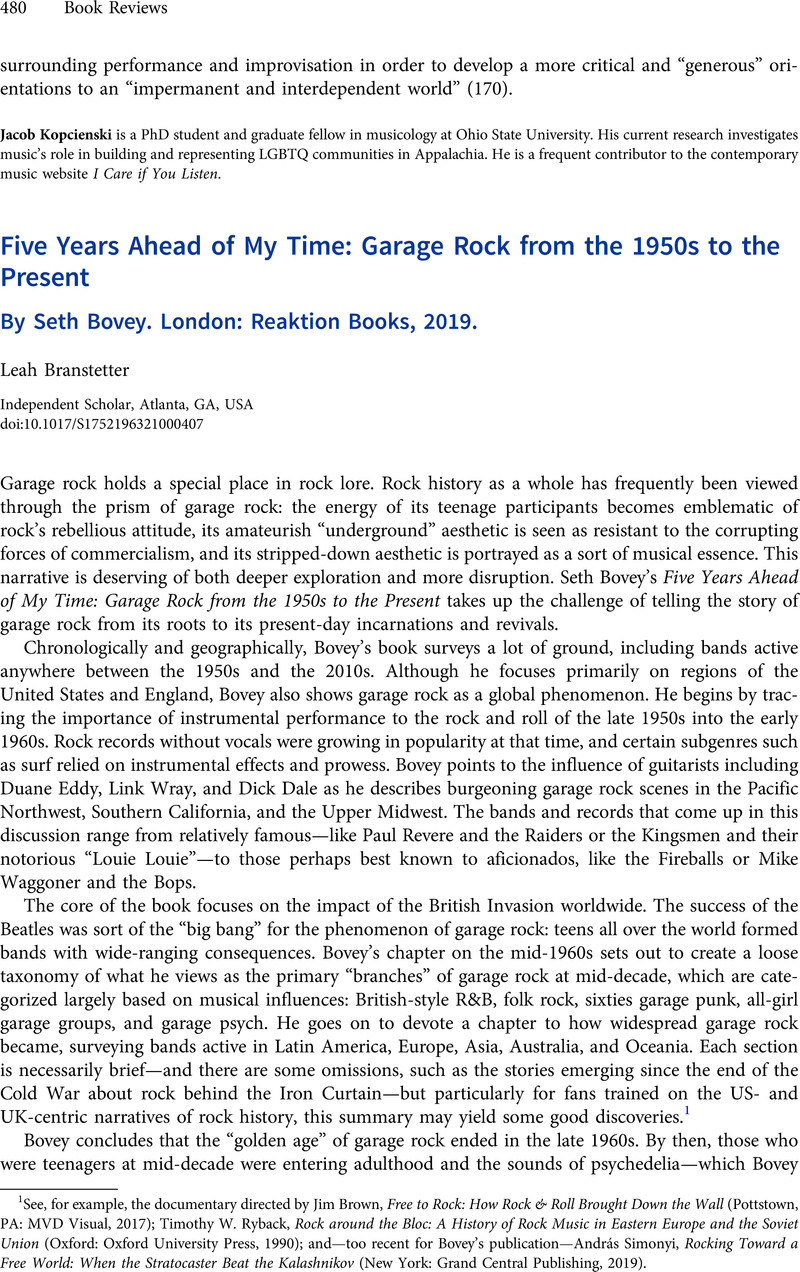No CrossRef data available.
Published online by Cambridge University Press: 22 December 2021

1 See, for example, the documentary directed by Brown, Jim, Free to Rock: How Rock & Roll Brought Down the Wall (Pottstown, PA: MVD Visual, 2017)Google Scholar; Ryback, Timothy W., Rock around the Bloc: A History of Rock Music in Eastern Europe and the Soviet Union (Oxford: Oxford University Press, 1990)Google Scholar; and—too recent for Bovey's publication—András Simonyi, Rocking Toward a Free World: When the Stratocaster Beat the Kalashnikov (New York: Grand Central Publishing, 2019).
2 Blecha, Peter, Sonic Boom: The History of Northwest Rock, from “Louie Louie” to “Smells Like Teen Spirit” (New York: Backbeat Books, 2009)Google Scholar; Joyson, Vernon, Fuzz, Acid and Flowers: A Comprehensive Guide to American Garage, Psychedelic and Hippie Rock (1964–1975) (Telford: Borderline, 2004)Google Scholar.
3 See Abbey, Eric James, Garage Rock and Its Roots: Musical Rebels and the Drive for Individuality (Jefferson, NC: McFarland, 2006)Google Scholar. This text does not come up in Bovey's book, but it essentially takes the opposite tactic: devoting chapters to theorizing garage rock but sticking to a more limited range of examples.
4 For just a few of many examples of scholarship on rock history narratives, see: Brooks, Daphne A., “The Write to Rock: Racial Mythologies, Feminist Theory, and the Pleasures of Rock Music Criticism,” Women and Music: A Journal of Gender and Culture 12, no. 1 (2008): 54–62CrossRefGoogle Scholar; Coates, Norma, “Teenyboppers, Groupies, and Other Grotesques: Girls and Women and Rock Culture in the 1960s and Early 1970s,” Journal of Popular Music Studies 15, no. 1 (2003): 65–94CrossRefGoogle Scholar; Hamilton, Jack, Just around Midnight: Rock and Roll and the Racial Imagination (Cambridge, MA: Harvard University Press, 2016)CrossRefGoogle Scholar; Mahon, Maureen, “Listening for Willie Mae ‘Big Mama’ Thornton's Voice: The Sound of Race and Gender Transgressions in Rock and Roll,” Women and Music: A Journal of Gender and Culture 15, no. 1 (2011): 1–17CrossRefGoogle Scholar; and the essays in Whiteley, Sheila ed., Sexing the Groove: Popular Music and Gender (New York: Routledge, 1997)Google Scholar.
5 Kheshti, Roshanak, “Musical Miscegenation and the Logic of Rock and Roll: Homosocial Desire and Racial Productivity in ‘A Paler Shade of White,’” American Quarterly 60, no. 4 (December 31, 2008): 1037–55CrossRefGoogle Scholar, https://doi.org/10.1353/aq.0.0040, 1050.
6 Jack Hamilton, Just around Midnight, 7.